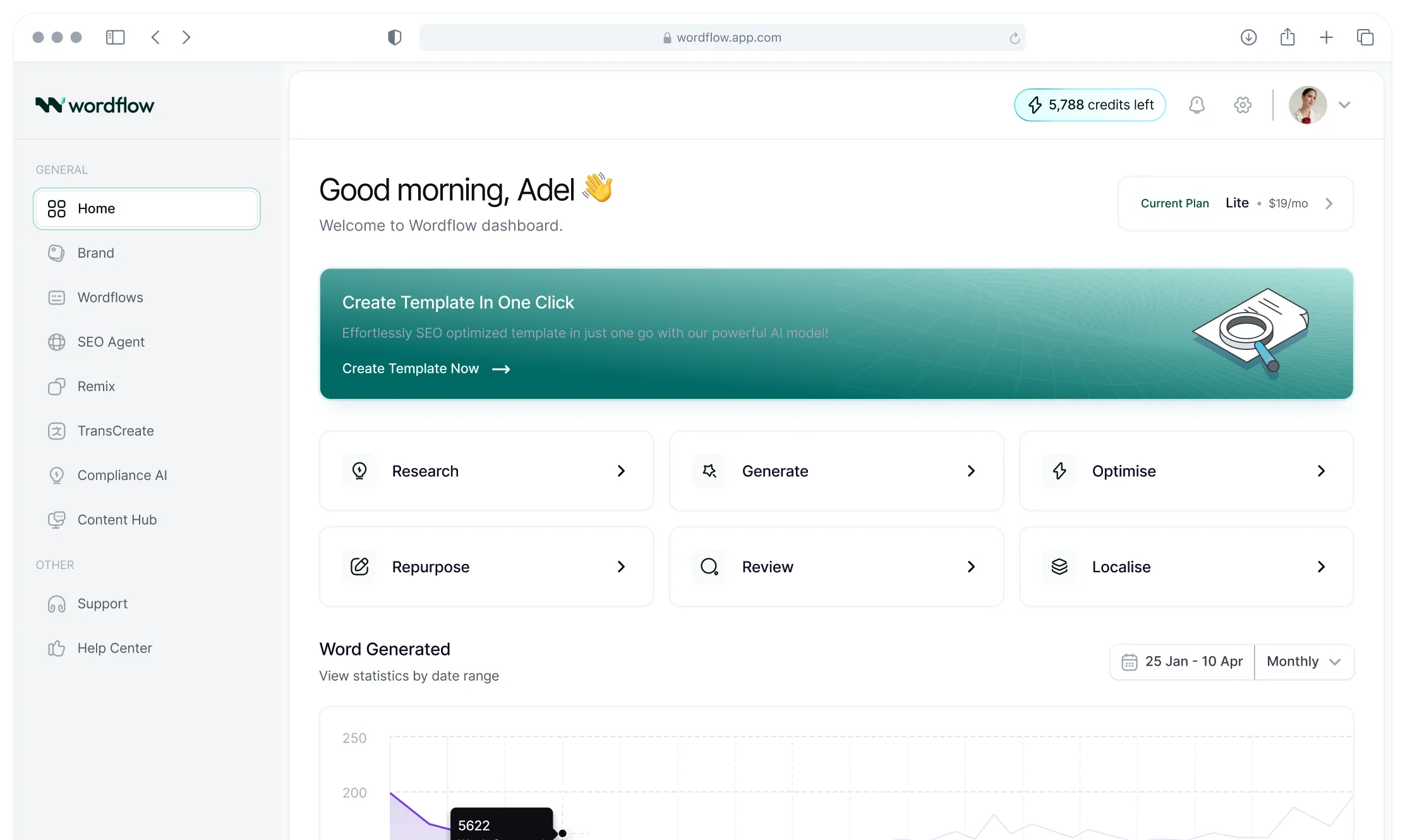
July 7, 2025
How a Unified AI Workspace Transforms Marketing Operations
Discover how a unified AI workspace transforms fragmented marketing operations into a seamless, efficient, and collaborative environment for better results.

How a unified AI workspace transforms marketing operations
Modern marketing teams are under pressure to move faster, create more, and maintain consistency across an ever-growing number of channels. But instead of streamlining operations, today’s tech stacks have often done the opposite, introducing more tools, more logins, and added complications. What began as a push for efficiency has evolved into a fragmented landscape where the core elements of marketing are spread across disconnected systems.
The result? Slower workflows, duplicated efforts, and missed opportunities for optimisation.
To stay competitive, marketers need more than just another tool; they need a new way of working. That’s where unified AI workspaces come in. By integrating key functions into a single, intelligent platform, these systems are transforming how marketing gets done.
The traditional marketing workflow
In most companies, a typical marketing campaign begins with a creative brief that gets passed between multiple stakeholders. The content team begins brainstorming ideas, often spending hours in meetings or navigating lengthy approval processes. After concepts are approved, the SEO team conducts keyword research using specialised tools, analysing search volumes, competition levels and ranking opportunities. Ideally, this research should inform the content strategy from the outset, but in many teams, it is still conducted separately.
Writers then create initial drafts based on the approved concepts and SEO insights. These drafts typically undergo review cycles that can last for days or weeks. A survey found that the average creative review process takes at least eight days and more than three versions to get sign-off. Because the research and writing are often handled in silos, SEO optimisation still risks being retrofitted rather than fully integrated. This means content creators may need to revise their work later to incorporate the SEO findings.
Meanwhile, the social media team prepares to adapt the content for various platforms, crafting tweets, Instagram captions, LinkedIn posts, and Facebook updates. Each platform requires different formatting, tone adjustments, and visual elements. The email marketing team simultaneously works on newsletter versions, while the paid advertising team creates ad copy variations for different campaigns and audiences.
This traditional workflow creates several pain points that marketing teams are all too familiar with. Projects move slowly through approval bottlenecks, with content often sitting in review queues while stakeholders coordinate schedules. Team members frequently duplicate research efforts, with different people investigating the same competitors, keywords, or market trends. Version control becomes a nightmare as multiple team members work on iterations of the same content across various platforms.
The fragmentation extends beyond internal processes. Marketing teams typically use separate tools for project management, content creation, SEO research, social media scheduling, email marketing, and analytics. Each tool requires its own login, has its own interface, and stores data in isolation. This leaves teams stuck with data scattered across different tools, making it hard to see how everything fits together.
Instead of stacking yet another tool on top, what if marketing teams could rethink the whole process with the help of AI?
The promise of unified AI workspaces
The emergence of AI-powered marketing platforms represents a fundamental shift from this fragmented approach. Rather than managing multiple disconnected tools, unified AI workspaces integrate the entire marketing workflow into a single, intelligent environment. These platforms use AI to automate routine tasks, generate insights, and facilitate seamless collaboration across all marketing functions.
What marketing teams want most from AI closely matches the benefits of a unified approach. According to The 2024 State of Marketing AI Report by the Marketing AI Institute, the top outcome marketers hope to achieve with AI is reducing time spent on repetitive, data-driven tasks, cited by 80% of respondents, up from 77% in 2023. The second most-desired outcome is gaining more actionable insights from marketing data, selected by 64% of respondents. This marks a notable rise from 2023, when it ranked fifth at 59%.
Unlike traditional marketing technology that simply digitises existing processes, AI platforms reimagine how marketing work gets done. They use machine learning to understand context, predict outcomes, and suggest optimisations that human teams might miss. More importantly, they break down the barrier between different marketing functions, creating a cohesive ecosystem where insights from one area immediately inform decisions in another.
Modern platforms, such as Wordflow, exemplify this unified approach by combining advanced AI capabilities with intuitive marketing workflows. Instead of expecting teams to adjust to rigid software requirements, these systems adapt to how marketing teams naturally work, enhancing their capabilities through intelligent automation.
Transforming campaign ideation and strategy
The creative process has traditionally relied heavily on human brainstorming sessions, competitive analysis, and intuition. While these elements remain valuable, AI workspaces enhance ideation by providing data-driven inspiration and eliminating creative blocks. Advanced language models can generate dozens of campaign concepts based on specific parameters, such as target audience, brand voice, and marketing objectives.
These AI systems analyse large amounts of market data, consumer behaviour patterns, and successful campaign examples to suggest innovative approaches that human teams might not consider. Additionally, they can identify emerging trends, seasonal opportunities, and content gaps that present strategic advantages. Rather than replacing human creativity, AI is an intelligent collaborator that expands the range of possibilities and accelerates the initial ideation phase.
The strategic planning process also benefits from AI's ability to process and synthesise information from multiple sources. Marketing teams can input competitor data, audience insights, and business objectives, and receive strategy recommendations that take into account all these variables. This eliminates the time-consuming research phase that traditionally precedes campaign development.
Streamlining content creation and production
Content creation is one of the most time-intensive aspects of marketing operations. Traditional workflows involve multiple rounds of writing, editing, and approval, with each revision requiring coordination among all teams involved. AI workspaces transform this process by providing intelligent writing assistance that understands brand voice, target audience, and content objectives.
Instead of starting from a blank page, writers can begin with a solid foundation shaped by the brand's voice and audience insights. Modern AI writing tools understand context, maintain consistency across various pieces of content, and can adapt tone and style for different audiences. Advanced platforms now feature customisable, AI-powered workflows that combine live research with performance goals to generate high-impact, brand-aligned copy in minutes rather than hours.
AI can handle repetitive tasks, such as formatting, fact-checking, and even first-round optimisation. Writers can focus on big-picture strategy and creative storytelling that brings human insight and authenticity to their content. This also speeds up the approval process since AI-generated content typically requires fewer revision cycles and maintains higher consistency with brand standards.
For companies managing multiple brands or client accounts, sophisticated brand profile systems can automatically apply the appropriate voice, tone, and business context to every piece of content. This helps maintain a consistent brand voice, even as teams handle different campaigns and clients automatically.
Enhancing SEO research and implementation
SEO has typically required specialised knowledge and significant time investment, with professionals spending hours analysing keywords, studying competitor strategies, and identifying content opportunities. AI workspaces simplify this by including SEO expertise directly into the content creation process, enabling all team members to optimise their work more easily.
For example, when a writer plans a blog about industry trends, AI can suggest fresh keywords, verify that the draft aligns with search intent, and recommend internal links, all before the draft reaches editors. By collaborating with established SEO tools and platforms, these systems enable teams to improve their rankings on Google and emerging AI-driven search engines without requiring deep technical skills.
The results speak for themselves: 65% of companies achieve better SEO results thanks to AI, while 76% saw their AI-generated content rank at least once. Additionally, 58% of all respondents reported that their AI-generated content achieved rankings at least a few times, demonstrating consistent performance rather than isolated successes.
This integration automates SEO best practices, removing the disconnect between content creation and optimisation, and allowing teams to produce search-optimised content from the very beginning instead of retrofitting it later.
Automating multi-channel content adaptation
One of the most tedious aspects of modern marketing involves adapting content for different channels and platforms. Each social media platform has its own requirements, audience expectations, and optimal posting formats. Email newsletters require different approaches than blog posts, and paid advertising copy needs to be crafted with specific campaign objectives in mind.
AI workspaces excel at this type of content adaptation because they understand the nuances of each platform and automatically adjust content to fit. A single blog post can be transformed into tweet threads, Instagram captions, LinkedIn updates, email segments, or ad copy, all with minimal effort.
That way, the brand’s voice stays consistent everywhere, even as messages are tailored to each audience. These systems understand character limits, hashtag strategies, visual requirements, and what resonates on each channel. Instead of manually rewriting the duplicate content, teams can focus on the strategy behind it, while AI ensures the delivery remains sharp and on brand.
Enabling efficient localisation and global reach
For companies operating in multiple markets, content localisation is a significant operational challenge. Localisation requires specialised translation services, cultural adaptation, and coordination with local marketing teams, which can be time-consuming and often delay global campaign launches.
However, AI workspaces like Wordflow now include culturally intelligent content adaptation capabilities that reach global audiences by adapting messages into over 40 languages while preserving tone and meaning for every market. These systems do more than translate; they adapt content to reflect cultural nuances and resonate with local audiences.
The localisation process becomes collaborative rather than sequential. Local marketing teams can provide input and feedback directly within the unified system, eliminating the communication delays that traditionally slow global campaigns. Real-time collaboration features allow teams across different time zones to work together efficiently, accelerating the entire process.
Integrating analytics and performance optimisation
Marketing analytics often operate separately from content creation and campaign management. Teams launch campaigns across multiple channels and then wait for performance data from different analytics platforms. This delay means optimisation happens too late or is missed altogether.
Unified AI platforms change this by integrating analytics directly into the workflow, delivering real-time insights that help teams act immediately. In fact, 75% of organisations now use AI analytics tools to support real-time, smarter decision-making. These systems track performance across all channels, identify trends, and recommend adjustments to boost effectiveness. Using machine learning, they also predict which content will perform best and spot upcoming seasonal trends and audience shifts.
With AI flagging underperforming content early and suggesting timely changes, teams can optimise campaigns continuously instead of reacting after budgets have been spent.
Facilitating seamless team collaboration
Perhaps the most transformative aspect of unified AI workspaces is how they improve team collaboration. Traditional marketing operations often struggle with communication breakdowns, unclear responsibilities, and duplicated efforts, partly because team members work across multiple disconnected tools. This makes it hard to track project status and coordinate effectively.
AI workspaces address this by providing a single platform where all marketing activities are visible in real-time. Team members can access shared resources, collaborate on content, and receive AI-generated updates that highlight urgent tasks and keep everyone informed. This collaborative environment spans across internal teams to include external partners, agencies, and freelancers, uniting everyone involved in marketing operations.
By consolidating communication and project management into one unified system, AI solutions eliminate the confusion and delays that arise from juggling multiple platforms, making collaboration smoother and more efficient.
The future of marketing operations
The transformation from traditional marketing operations to AI-powered unified workspaces is more than a technological upgrade; it's a fundamental reimagining of how marketing work gets done. The benefits are not limited to efficiency gains but also include strategic capabilities that can provide significant competitive advantages.
For marketing teams ready to embrace this transformation, unified AI platforms offer a natural evolution of current processes rather than a disruptive replacement. These systems can integrate with existing tools and workflows while gradually automating routine tasks and providing intelligent insights.
The key to successful transformation lies in viewing AI as an amplifier of human capabilities rather than a replacement for human judgment. The most effective AI-powered marketing operations combine the efficiency and analytical power of artificial intelligence with the creativity, strategic thinking, and emotional intelligence that humans bring to marketing.
As the marketing landscape continues to evolve, teams that successfully integrate AI into their operations will be better positioned to deliver personalised, timely, and effective campaigns while maintaining the strategic focus that drives business results. The future of marketing operations is already here; it's simply waiting for teams ready to embrace it.
For companies ready to lead this transformation, Wordflow's AI-powered platform offers an opportunity to consolidate brand management, content workflows, and compliance processes into a unified, intelligent workspace that drives both efficiency and strategic outcomes.
Read More
Artifical Intelligence.
Real Results
Get started with Wordflow—the agentic platform built for modern marketers. Start your free 7-day trial today and experience the difference.








